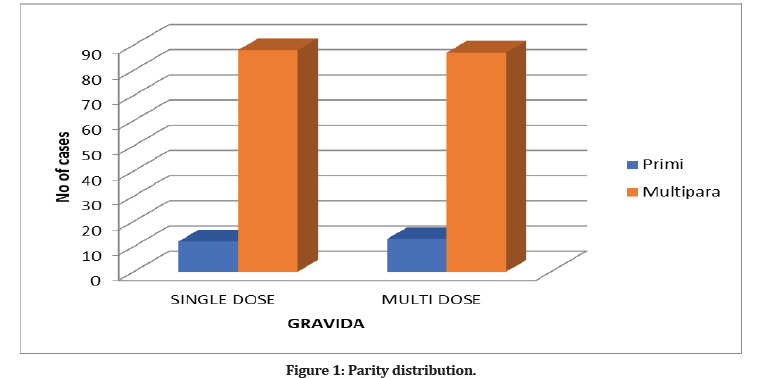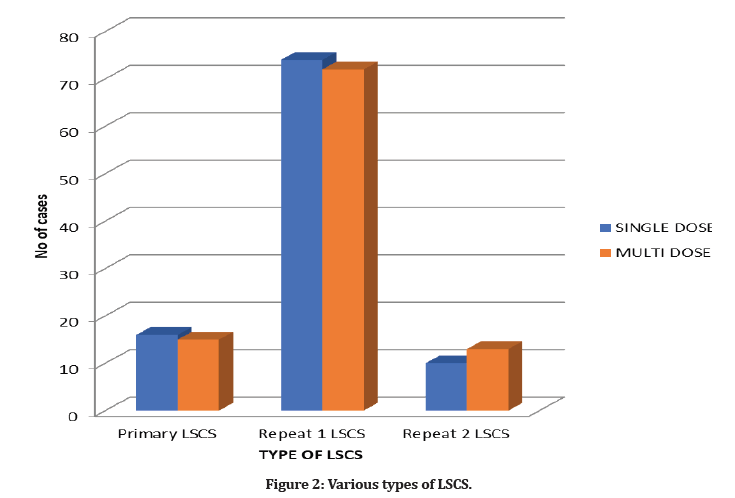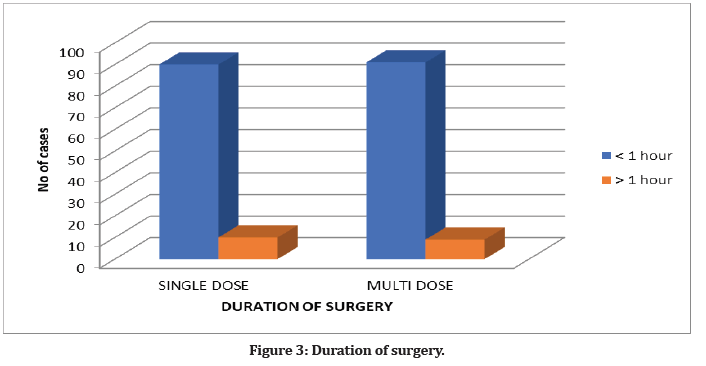Research - (2022) Volume 10, Issue 6
Multiple Doses Different from Single Dose in Antibiotic Prophylaxis in Voluntary Caesarean Fragment
Kalpana Thalava and G Jayalakshmi*
*Correspondence: G Jayalakshmi, Department of Obstetrics and Gynaecology, Sri Lakshmi Narayana Institute of Medical Sciences Affiliated to Bharath Institute of Higher Education and Research, Chennai, Tamil Nadu, India, Email:
Abstract
To assess the efficacy of single-dose antibiotic prophylaxis (AP) vs. usual multiple-dose AP in individuals receiving elective caesarean section in terms of postoperative infectious sequelae. Reducing the amount of antibiotic doses will ease the likelihood of the formation of drug-resistant microorganisms and will also protect the majority group of cases from needless drug exposure. The single-dose antibiotic is secure, efficient, easy to use, and cost-efficient. It is also preferable in low-risk and regular caesarean section patients. In this era of developing antibiotic resistance, reducing antibiotic use has become a must, and this research has provided encouraging evidence in that regard. This research found that single-dose prophylactic antibiotics are just as effective as multiple-dose PA in elective routine cesarean sections.
Keywords
Liver diseases, Steroid therapy, Diabetes mellitus, Tuberculosis, Hypertension, Anaemia
Introduction
The caesarean section has turn out to be one of the more popular surgical operations in the world over the last several decades, with a growing tendency in both developing and developed countries. Even if caesarean sections are considered a safer method than vaginal birth for some medical grounds, the danger of the surgery surpasses the advantages in the absence of the medical need. In particular, as compared to women who deliver vaginally, women who have a caesarean birth have a 5-20-fold higher risk of infection complications [1,2].
Given the concerning trend of increased cesarean deliveries, interventions to reduce infectious problems have acquired greatest importance and are a major emphasis [3]. Traditional concepts of skin-antisepsis, comprehensive and sterile-surgical methods, and antibiotic prophylaxis have all been shown to be beneficial in preventing infectious problems after any surgery. Although the American Congress of Obstetricians and Gynecologists advise single-dose antibiotic prophylaxis for cesarean sections [4]. In our subcontinent, where sick people are from lower socioeconomic strata, are nutritionally questioned, and have lower academic credentials, the efficacy of a single-dose antibiotic protocol must be proven to work, in order to alleviate consultants' concerns about using fewer amounts [5].
Maternal mortality following labour and delivery, including during the puerperium, is a source of worry for both health care providers. Obstetric haemorrhage is one of the primary reasons of maternal bereavement in India. Despite breakthroughs in numerous treatment modalities including as detection and antibiotic therapy, it continues to be a significant cause to MMR. Despite the fact that it does not always result in the mother's death, puerperal sepsis is a major source of longterm morbidity, such as persistent pelvic discomfort, subsequent infertility, and ectopic-pregnancy [6,7]. The rising expense of treatment, along with the growing needs for hospital beds, has fueled the hunt for better strategies to reduce postoperative morbidity and reduce hospital stays. The focus of this research is to compare infectious morbidity between single and repeated doses of the same treatment in order to determine the best antibiotic prophylaxis regimen for cesarean delivery and to compare the cost efficiency of both regimens [8].
Methods
Study type: Comparative study.
Duration: From September 2019 to March 2021 for duration of 18 months.
Place of study: Department of Obstetrics and Gynaecology, Sri Lakshmi Narayana Institute of Medical Sciences, Chennai, India.
Participants: There were 200 respondents for the study, categorized into two parts of 100 each. The study relied on the criteria for inclusion and exclusion.
Inclusion criteria
Women undertaking elective caesarean, regular antenatal check-up.
Patients willing to participate in the study.
Irregular antenatal-period.
Exclusion criteria
Renal impairment.
Liver diseases.
Steroid therapy.
Diabetes mellitus.
BMI greater than 25.
HIV patient’s taken renal transplant.
Prolonged preoperative hospitalization.
Standard definitions
Pus drained
If pus was removed, it was submitted for pus culture and susceptibility testing, and the resulting organism was treated based on antibiotic sensitivity. It was examined once the data was collected. The statistical significance of both subgroups was assessed using the paired t test. For data analysis, IBM SPSS software version 21 was employed.
Results
The parity distributions of dosages were presented in Figure 1. 6 percent of those in group I, the single dosage group, were under the age of 20, 41 percent were between the ages of 21 and 25, 38 percent were between the ages of 26 and 30, 11 percent were between the ages of 31 and 35, and 4 percent were beyond the age of 35. In group II, the multidose group, 7% of the patients were below the age of 20, 40% were ranging the ages of 21 and 25, 37% were ranging the ages of 26 and 30, 11% were ranging the ages of 31 and 35, and 5% were over the age of 35.

Figure 1: Parity distribution.
In the overall instances, 12 percent of the single dosage group had primi and 88 percent had multipara, whereas 13 percent and 87 percent of the multi dose group had the same. The majority of people in both groups had multipara gravid, as seen in the table above. The bulk of the surgeries in both categories were repeated, with 84 percent in group I and 85 percent in group II (Figure 2). The main CS performed in multiparous individuals has the lowest percentage of surgeries in both categories, with 4 percent and 2 percent in groups I and II, correspondingly. In primiparous women in groups I and II, CS is done at a rate of 12 percent and 13 percent, respectively.

Figure 2: Various types of LSCS.
In the single dosage group, 6% of the patients had UTI Distribution, whereas in the multi dose group, 5% had UTI Distribution. In terms of hospitalization length, the p.value is not less than 0.05 for any one of the group.
Purulent Discharge was found in 3% of single dosage patients and 2% of multidose cases, respectively. In the single dosage group, 1% of patients had abnormalvaginal discharge, whereas in the multiple dose groups, 1% of subjects had unusual vaginal discharge (Figure 3).

Figure 3: Duration of surgery.
Discussion
The major goal of preventive antibiotics is to minimize infection and, as a result, morbidity and death. To guarantee a high plasma concentration of antibiotic throughout the surgery, perioperative antibiotic treatment is required while delivering prophylaxis for caesarean section. Several recent investigations in obstetric situations have demonstrated that prophylactic antibiotics play an important role. In this study, 200 people were engaged and separated into two groups: study and control. Statistical study of several factors revealed that the whole number of patients was divided into similar groups. Antibiotic prophylaxis was given to all participants in the research group half an hour beforehand surgery, and those on multiple dosage regimens got further doses postoperative, with postoperative outcomes compared [9,10].
In terms of coinfection, there was no difference in the length and amount of antibiotics utilized. There was no statistically significant difference in results whether the antibiotic was administered for a short or extended period of time. The relevance of antibiotic medication timing in avoiding postoperative infection has been shown [11,12]. In their Cochrane study, the authors determined that there is no difference in the timing of antibiotic prophylaxis delivered before or after cord clamp. In this research, six patients in group I experienced fever morbidity, whereas five patients in group II had febrile morbidity. The temperatures of these individuals were over 38 degrees after 24 hours following the caesarian surgery, and it continued for 3 to 5 days on median. A wound sample was collected and submitted for pus culture and sensitivity testing because the patients had related abdominal wound infections [13]. Appropriate antibiotics were switched as needed.
When Shah et al. compared febrile morbidity in 2014, they found results that were comparable to the current research (P value is 0.1139). In the abovementioned study, there was no significant disparity in any postoperative problems, although the study found a statistically significant difference in the average price between the two study groups. Three participants in group 1 experienced purulent discharge on postoperative days 5 and 6. An exploratory injection of Cefotaxime 1 g IV BD was begun, and a wound sample was submitted for pus culture and sensitivity testing [14]. E. coli growth was seen in one individual, Staph aureus growth in another, and Klebsiella growth in a third. Except for the Klebsiella, which demonstrated tolerance to Cefotaxime, all of the organisms were responsive to injectable Cefotaxime. Cefotaxime 1g IV BD injection was maintained for 5 days. However, Klebsiella was sensitive to piperacillintazobactam and meropenem, with ciprofloxacin sensitivity being moderate. In this study, the incidence of UTI was reported to be 6% in group I and 5% in group II, correspondingly.
There was no statistically significant difference. Similar findings were also found in a research. When a UTI was discovered, a urine culture and sensitivity test was performed, and antibiotics were prescribed based on the sensitivity [15,16]. When it comes to postoperative complications, we found that single dose antibiotic prophylaxis is just as beneficial as multiple dose antibiotic prophylaxis in our research [17]. Furthermore, using antibiotics for a shorter period of time reduces the danger of developing drug-resistant bacteria, which is a problem in today's world when antibiotic use is common. Additional antibiotic doses should be reserved for highrisk situations alone, saving the vast majority of patients from needless medication administration [18].
Conclusion
In this era of developing antibiotic resistance, reducing antibiotic use has become a must, and this study has provided encouraging evidence in that regard. This study found that single-dose prophylactic antibiotics are just as effective as multiple-dose prophylactic antibiotics in elective straightforward cesarean delivery. As an extra benefit, single-dose prophylaxis is less expensive than multi-dose prophylaxis since the amount and time of antibiotic administered is much lower. It lessens the cost burden on patients and the government in terms of delivering antibiotics. Furthermore, because there are fewer intravenous infusions, single-dose antibiotic prophylaxis is comfortable not only for the individual but also for the medical staff. It also offers the added benefit of protecting the vast majority of patients from needless medication exposure because further antibiotic doses are only given in high-risk instances.
References
- Gibbs RS. Clinical risk factors for puerperal infection. Obstet Gynecol 1980; 55:178sâ??84.
- Bagratee JS, Moodley J, Kleinschmidt I, et al. A randomized controlled trial of antibiotic prophylaxis in elective caesarean delivery. Br J Obstetr Gynaecol 2001; 108:143-148.
- Owen J, Andrews WW. Wound complications after caesarean sections. Clin Obstet Gynecol 1994; 37:842â??855.
- Arnold KC, Flint CJ. Use of prophylactic antibiotics in labor and delivery. In Obstetrics Essentials Springer 2017; 129-133.
- Robson MS. Can we reduce the caesarean section rate?. Best Pract Res Clin Obstet Gynaecol 2001; 15:179-194.
- Hopkins L, Smaill FM. Antibiotic prophylaxis regimens and drugs for cesarean section. Cochrane Database Syst Rev 1999.
- Rasa K, Kilpatrick C. Implementation of World Health Organization guidelines in the prevention of surgical site infection in low-and middle-income countries: what we know and do not know. Surg Infect 2020; 21:592-598.
- Smaill FM, Grivell RM. Antibiotic prophylaxis versus no prophylaxis for preventing infection after cesarean section. Cochrane Database Syst Rev 2014.
- Bollig C, Nothacker M, Lehane C, et al. Prophylactic antibiotics before cord clamping in cesarean delivery: A systematic review. Acta Obstet Gynecol Scand 2018; 97:521â??535.
- https://www.textbooks.com/Telindes-Operative-Gynecology/9780781728591/Rock.php
- Roex AJ, Puyenbroek JI, Van Loenen AC, et al. Single-versus three-dose cefoxitin prophylaxis in caesarean section: A randomized clinical trial. Eur J Obstetr Gynecol Reproduc  Biol 1987; 25:293-298.
- Robinson HE, O’Connell CM, Joseph KS, et al. Maternal outcomes in pregnancies complicated by obesity. Obstetr Gynecol 2005; 106:1357-1364.
- https://www.worldcat.org/title/surgery-of-theodoric/oclc/14652749
- Alexander JW. The contributions of infection control to a century of surgical progress. Ann Surg 1985; 201:423â??428.
- Meade RH. An introduction to the history of general surgery. Philadelphia WB Saunders 1968; 29â??37.
- Noel GJ. Clinical profile of ceftobiprole: A novel Ã?-lactam antibiotic. Clin Microbiol Infect 2007; 13:25-29.
- https://accessmedicine.mhmedical.com/content.aspx?bookid=1613§ionid=102124003
- Shetty J, Rajshekhar S, Kamath A. Short term antibiotic prophylaxis for emergency cesarean delivery: Is there a difference?. Internet J Gynecol Obstetr 2008; 11:1-7.
Indexed at, Google Scholar, Cross Ref
Indexed at, Google Scholar, Cross Ref
Indexed at, Google Scholar, Cross Ref
Indexed at, Google Scholar, Cross Ref
Indexed at, Google Scholar, Cross Ref
Indexed at, Google Scholar, Cross Ref
Indexed at, Google Scholar, Cross Ref
Indexed at, Google Scholar, Cross Ref
Indexed at, Google Scholar, Cross Ref
Indexed at, Google Scholar, Cross Ref
Indexed at, Google Scholar, Cross Ref
Author Info
Kalpana Thalava and G Jayalakshmi*
Department of Obstetrics and Gynaecology, Sri Lakshmi Narayana Institute of Medical Sciences Affiliated to Bharath Institute of Higher Education and Research, Chennai, Tamil Nadu, IndiaCitation: Kalpana Thalava, G Jayalakshmi, Multiple Doses Different from Single Dose in Antibiotic Prophylaxis in Voluntary Caesarean Fragment, J Res Med Dent Sci, 2022, 10 (6):255-258.
Received: 16-May-2022, Manuscript No. JRMDS-22-66694; , Pre QC No. JRMDS-22-66694 (PQ); Editor assigned: 18-May-2022, Pre QC No. JRMDS-22-66694 (PQ); Reviewed: 02-Jun-2022, QC No. JRMDS-22-66694; Revised: 07-Jun-2022, Manuscript No. JRMDS-22-66694 (R); Published: 14-Jun-2022
